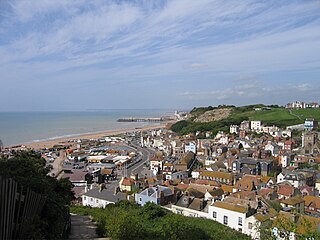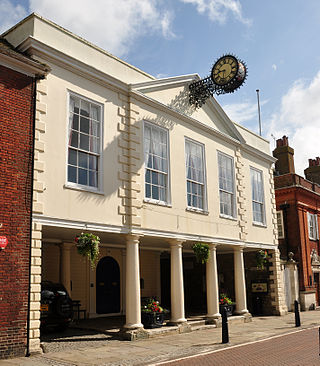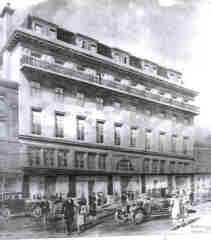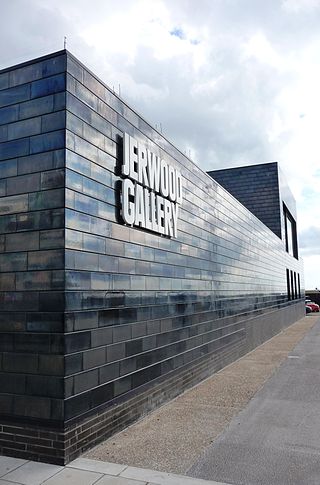
Hastings is a large seaside town and borough in East Sussex on the south coast of England, 24 mi (39 km) east to the county town of Lewes and 53 mi (85 km) south east of London. The town gives its name to the Battle of Hastings, which took place 8 mi (13 km) to the north-west at Senlac Hill in 1066. It later became one of the medieval Cinque Ports. In the 19th century, it was a popular seaside resort, as the railway allowed tourists and visitors to reach the town. Today, Hastings is a fishing port with the UK's largest beach-based fishing fleet. It has an estimated population of 92,855 as of 2018.

Lewes is the county town of East Sussex, England. The town is the administrative centre of the wider district of the same name and the location of East Sussex County Council at the county hall.

Orpington is a town and area in south east London, England, within the London Borough of Bromley. It is 13.4 miles south east of Charing Cross.

Hythe is a market town and civil parish on the edge of Romney Marsh, in the district of Folkestone and Hythe in Kent, England. The word Hythe or Hithe is an Old English word meaning haven or landing place.

Rye is a small town and civil parish in the Rother district of East Sussex, England, two miles from the sea at the confluence of three rivers: the Rother, the Tillingham and the Brede. An important member of the mediaeval Cinque Ports confederation, it was at the head of an embayment of the English Channel, and almost entirely surrounded by the sea.

St Leonards-on-Sea is a town and seaside resort in the Borough of Hastings in East Sussex, England. It has been part of the borough since the late 19th century and lies to the west of central Hastings. The original part of the settlement was laid out in the early 19th century as a new town: a place of elegant houses designed for the well-off; it also included a central public garden, a hotel, an archery, assembly rooms and a church. Today's St Leonards has extended well beyond that original design, although the original town still exists within it.

East Sussex College or East Sussex College Group is the largest higher education college in East Sussex, providing education and training from foundation to degree level. The college educates almost half of the county's young people and over 8,000 adults each year at campuses in Lewes, Eastbourne, Hastings and Newhaven, and in the workplace.

Henry Ward ARIBA was a British architect who designed many large public buildings in and around Hastings, East Sussex, some of which are listed buildings.

Horntye Park Sports Complex is a sports and conference centre in Hastings, East Sussex, England. Primarily known as a cricket ground, the venue also contains a large indoor sports hall, an all-weather pitch used for football and hockey and a series of rooms used for meetings, conferences and weddings. The venue is the former home ground of Hastings & St. Leonards Priory Cricket Club and currently home to South Saxons Hockey Club.

Silverhill is a suburb and local government ward of Hastings, East Sussex, England. It has a central location within the town, where the A21 meets the B2159 road.

The Central Recreation Ground was a cricket ground in Hastings, East Sussex, used for first-class and List A cricket between 1864 and 1996. The ground was frequently used by Sussex County Cricket Club as one of their outgrounds from 1865; in total, Sussex played 143 first-class and 17 List A matches at the ground. Between 1887 and the 1960s, the Central Recreation Ground also played host to the Hastings & St Leonards cricket festival, which attracted many other teams and notable players. In the early twentieth century, the ground hosted seven Gentlemen v Players matches, and notable players to have played at the ground include W.G. Grace, Don Bradman, Jack Hobbs and Denis Compton. Grace made over 40 appearances at the ground, whilst both Hobbs and Compton broke the record for most first-class centuries in a season at the Central Recreation Ground. The ground also hosted a women's one-day international between England and New Zealand in 1984. In the 1980s, planning permission was given for the ground be demolished, and the land used to build a shopping centre. After the demolition of the ground in 1996, the Priory Meadow Shopping Centre was built on the site.

Holy Trinity Church is an Anglican church in the centre of Hastings, a town and borough in the English county of East Sussex. It was built during the 1850s—a period when Hastings was growing rapidly as a seaside resort—by prolific and eccentric architect Samuel Sanders Teulon, who was "chief among the rogue architects of the mid-Victorian Gothic Revival". The Decorated/Early English-style church is distinguished by its opulently decorated interior and its layout on a difficult town-centre site, chosen after another location was found to be unsuitable. The church took eight years to build, and a planned tower was never added. English Heritage has listed the building at Grade II* for its architectural and historical importance.

St Luke's Church is a United Reformed church in the Silverhill suburb of Hastings, a town and borough in East Sussex, England. The congregation was originally independent before taking up Presbyterianism, and worshipped in a private house from its founding in 1853 until a permanent church was provided in 1857; this was one of the oldest Presbyterian places of worship in southeast England. The growth of the community has resulted in several extensions since then, and severe damage caused by the Great Storm of 1987 was quickly repaired—except for the loss of the building's distinctive spire. The church, along with most other Presbyterian congregations, joined the United Reformed Church when that denomination was formed in 1972. It is one of four United Reformed Churches in the borough of Hastings.

Hastings United Football Club, previously known as Hastings Town, is a semi-professional football club based in Hastings, East Sussex. They currently play in the Isthmian League Premier Division and have played their home games at The Pilot Field since 1985, after the demise of the previous Hastings United, whose identity they took on following a name change in 2002.

John Howell & Son, known as John Howell, was the leading building and engineering company in Hastings, Sussex in the 1860s. Its founder, John Howell Senior (ca.1825−1893) engineered churches and other public buildings in the area to the designs of innovative architects, including Holy Trinity Church in 1860 to the design of Samuel Sanders Teulon, and St Johns Church, Hollington in 1865−1868 for Edward Alexander Wyon. John Howell Junior (1851−1903) constructed the old Gothic Revival Hastings Grammar School building to the design of Jeffery and Skiller in 1883. Howell Senior was a campaigner on behalf of the Liberal Party and held a prominent political position in the town from the 1860s to the 1880s. He came to Hastings as a fatherless boy, but was the Mayor of Hastings by 1878.


The Observer Building is a building on Cambridge Road, Hastings, England. It was originally occupied by the print works and editorial offices of the Hastings & St. Leonards Observer newspaper. Between 1924 and 1984 it housed 500 employees. The building later became a significant local landmark, and was described as "one of the most imposing [buildings] in Hastings" by the BBC News.

Robertson Street Congregational Church is a former United Reformed church in the centre of Hastings, a seaside town and borough in East Sussex, England. Built in 1885 on the site of an earlier church which had been constructed in 1857, it was designed by Henry Ward (1854–1927), who was responsible for many of the key buildings in the town of Hastings, not least the Town Hall. The building, a "large urban ... church with richly detailed exteriors and interiors", is situated between Robertson Street and Cambridge Road and has a split-level arrangement with part of the gallery occupying a flying freehold over the alleyway adjacent to the entrance on Robertson Street. The church is listed at Grade II for its architectural and historical importance.

Wellington Square Baptist Church is a Baptist church in the centre of Hastings, a town and seaside resort in East Sussex, England. It was built in 1838 for a congregation which had previously been meeting for worship in hired premises, and it has been in continuous use since then. Rev. W. Barker, a long-serving minister in the 19th century, revived the church after it was split by a secession and later helped to establish Baptist chapels in two other parts of Hastings. The church forms the northwest corner of Wellington Square, one of the town's earliest residential developments, and its stuccoed Neoclassical exterior harmonises with the surrounding houses. Historic England has listed the church at Grade II* for its architectural and historical importance.

St Leonards Pier, also known as the Palace Pier, was a public pleasure pier in St Leonards-on-Sea, part of the town and borough of Hastings in East Sussex, England. Opened in 1891 the pier was a direct rival to nearby Hastings Pier, and during its heyday the pier was a leading tourist attraction, and was described in the 1894 Baedeker travel guide as handsome. The pier was damaged during WW2 and left derelict after the war until purchased by Hastings Corporation in 1951 who demolished the structure over the next two years.




















